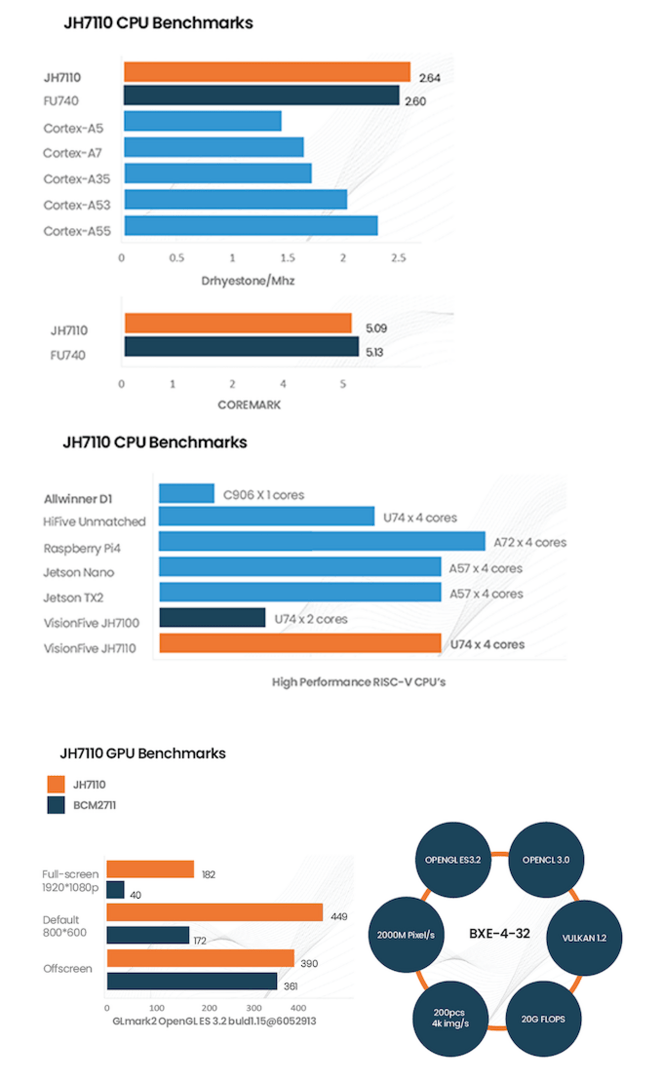The VisionFive 2 from the Chinese company StarFive, which was co-founded by SiFive, is the first single-board computer based on the open instruction set architecture RISC-V that can boast a 3D graphics processor. The SiFive JH7100 is combined with an IMG BXE-4-32 MC4 from Imagination Technologies.
RISC-V with 3D GPU for the first time
The combination of the new SiFive JH7110, a quad-core RISC-V processor with four 1.5 GHz fast U74 processor cores, and the GPU Imagination BXE-4-32 MC4, which controls Vulkan and OpenCL and can fall back on four computing units and 16 texels, enables StarFive to present the first mini-PC based on the open source instruction set architecture (ISA) with a 3D graphics unit.


StarFive VisionFive 2 with Imagination 3D GPU (Image: StarFive)
The single-board computer is the successor to the StarFive VisionFive V1, but in particular it should offer significantly more multi-core performance and be much cheaper to buy. The RISC-V system was already offered on Kickstarter from 49 US dollars, now at least 55 US dollars are due in this country.
For a maximum of 85 US dollars later In crowdfunding, users interested in the RISC-V architecture are to receive the following hardware:
- SiFive JH7110 RISC -V System on a Chip (PDF)
- SiFive U74 quad-core @ 1.5GHz
- 2MB L2 cache
- 64-bit
- Imagination IMG BXE-4-32 MC4
- 4 compute units and 16 texels
- OpenGL 3.2, OpenCL 3.0, Vulkan 1.2
- H.264/H.265 4K @ 60 FPS decoding
- H.265 1080p @ 30 FPS encoding
- 2, 4, 8 GB LPDDR4- 2800 SDRAM
- 2 × USB 3.0 and 2× USB 2.0
- 2 × Gigabit Ethernet
- Wi-Fi 5 with 2.4 GHz*
- 100 × 72mm
*) Wi-Fi 5 optional via the M.2 slot
Via the 40-pin GPIO connector known from the Raspberry Pi and two MIPI DSI and CSI ports can be used to connect compatible displays and cameras to the single-board computer.
RISC-V in Raspberry format for Linux
The flagship of the single-board computer, whose performance level should be located slightly below a Raspberry Pi 4, according to the manufacturer, is in any case the Imagination IMG BXE-32 MC4, which according to the British manufacturer controlled by the Chinese investor Canyon Bridge Capital Partners, among other things for intended for the automotive, handheld consoles and media players as well as set-top boxes and smart TVs. The GPU delivers 128 GFLOPS (FP32) and 16 gigapixels/s.
-
 IMG BXE-4-32 MC4 GPU by Imagination (Image: Imagination)
IMG BXE-4-32 MC4 GPU by Imagination (Image: Imagination)
Image 1 of 2
 IMG BXE-4-32 MC4 GPU from Imagination (Image: Imagination)
IMG BXE-4-32 MC4 GPU from Imagination (Image: Imagination)Later up to 6 TFLOPS and AI support
The GPU from the PowerVR B series is to be installed in even larger expansion stages in upcoming RISC-V systems, which can also be expanded by an AI unit (NPU) and have a performance of up to 6 TFLOPS and 192 gigapixels/s and 24 TOPS for computing artificial intelligence.


IMG BXM -4-64-MC4 and IMG BXT-32-1024 MC4 (Image: Imagination)
The manufacturer discloses the expected performance values on the project page on the crowdfunding platform Kickstarter and publishes both the first CPU and GPU benchmarks of the 100 × 72 mm single-board computer. In addition, StarFive compares the VisionFive 2 with its predecessor and the current Raspberry Pi.
-
 The StarFive VisionFive 2 in the CPU and GPU benchmark (Image: StarFive)
The StarFive VisionFive 2 in the CPU and GPU benchmark (Image: StarFive)
Image 1 of 3


StarFive VisionFive 1 and VisionFive 2 as well as Raspberry Pi 4 in comparison (Image: StarFive)
Debian, Fedora, openSUSE and Ubuntu
System images are now available via the project page on the GitHub developer platform available for the distributions Debian and Fedora, openSUSE and Ubuntu are to follow soon. The developers demonstrate the 3D capability of the system with the games Quake 3D and Metal Slug as well as GLMark2.
Quake 3D, Metal Slug and GLMark2 demonstrate the 3D capabilities (Image: StarFive)
Just a few days ago, SiFive and the British Linux distributor Canonical announced that the current Ubuntu 22.04 LTS (“Jammy Jellyfish”) now also runs on the open source architecture RISC-V.
RISC-V and Linux should benefit from each other
As Cindy Goldberg, vice president of Silicon Alliance at Canonical and Thomas Xu, StarFive founder and CEO, in a joint announcement, SiFive, StarFive and Canonical are partnering to advance Ubuntu and Linux on the RISC-V architecture.